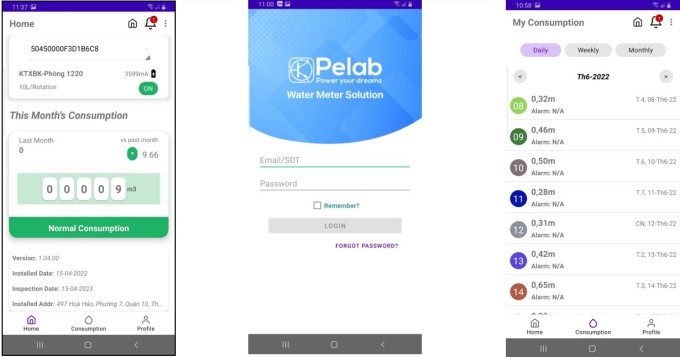Using wireless transmission technology, a team of scientists from Ho Chi Minh City University of Technology has integrated a module into water meters to make them smart, alerting users to unusual water usage or potential theft.
The research, led by Master Nguyen Hoai Phong from the Department of Electrical Engineering, has been underway since 2018 with the aim of creating a high-tech product that can replace imported devices.
The scientists developed an integrated module device that can be attached to conventional mechanical water meters. The device consists of three main components: a circuit board that records water usage via an electrical pulse mechanism and stores data in a processor, an LC sensor to detect reverse pumping behavior (interference that causes the meter to spin backward to steal water), and a battery that powers the electronic components.
The team employs two wireless technologies, Lora and NB-IoT, to transmit data from the water meter to a server. They also developed an application to manage all activities of the water meter. Users can download the application onto their computers or smartphones, where data is transmitted for real-time monitoring of water usage, allowing them to cross-check with data from the water supply unit.
According to the research team, the application also allows users to set an average water usage limit. If this threshold is exceeded, the system will automatically alert users on the screen. “The device can also sound an alarm if someone unauthorized opens the module’s protective cover,” Master Phong stated.

Image of the device attached to a mechanical water meter. (Photo: NVCC)
Lora and NB-IoT are two wireless transmission technologies that utilize radio waves. Mr. Phong explained that with Lora technology, there are no subscription fees from network providers, but users must install a gateway to control the modules attached to the water meters. The operating range of this technology is about 2-5 kilometers, making it suitable for small areas with minimal obstacles. On the other hand, NB-IoT technology incurs subscription costs, and coverage depends on the network provider. This technology is more suitable for larger areas with obstructed spaces. “Depending on the number of modules and the conditions of each area, the appropriate transmission technology should be chosen,” Mr. Phong added.
The modules are designed to be dust and water-resistant, suitable for operation in harsh environmental conditions, with a battery life of up to 6 years.
According to the author, depending on the investor’s needs, the battery capacity can be increased at a higher cost. For areas with existing water meters, the installation of the system takes only about half a day. The research team provides server services for users or can guide them through the setup steps if the customer already has a server system. Data from the server updates every 24 hours by default and can be increased to a maximum frequency of once per hour, depending on settings. The more frequent the water monitoring, the higher the battery consumption.

Interface of the smart water meter management application developed by the team. (Photo: NVCC).
The price for a module integrated into a water meter is approximately 1.3 – 1.8 million VND, including 2 years of free software and server usage. This price is based on a production scale of 100 units. If the order quantity is larger, the price will be lower. Some smart water meters from the USA and Europe cost 4 – 5 million VND, or even more, according to the research team.
The product has been experimentally installed in 60 water meters at the dormitory of Ho Chi Minh City University of Technology since 2021, as well as in some residential areas and factories in Dong Thap and Tien Giang provinces. Results show that real-time data transmission has an error rate of less than 5%.
Mr. Vo Nhat Tan, a representative of Saigon Water Supply Company (Sawaco), stated that Ho Chi Minh City has approximately 1.6 million water meters managed by the unit. Among these, there are about 40,000 imported smart meters along with domestic suppliers.
Regarding the research of the team, Mr. Tan assessed that while Lora uses free radio waves, this transmission method requires open spaces. In densely populated areas with many other transmission devices, interference can affect data transmission. NB-IoT technology, on the other hand, features low power consumption, making it suitable for crowded residential areas. However, this technology depends on the investment in transmission lines by the network provider.
According to Mr. Tan, in addition to data transmission technology, the quality of the internal devices of smart water meters is also very important. After 1-2 years of use, the accuracy of the data may decline. “Data must always be accurate for us to integrate it into customer service tools, ensuring that water billing is always precise,” the Sawaco representative stated.



















































